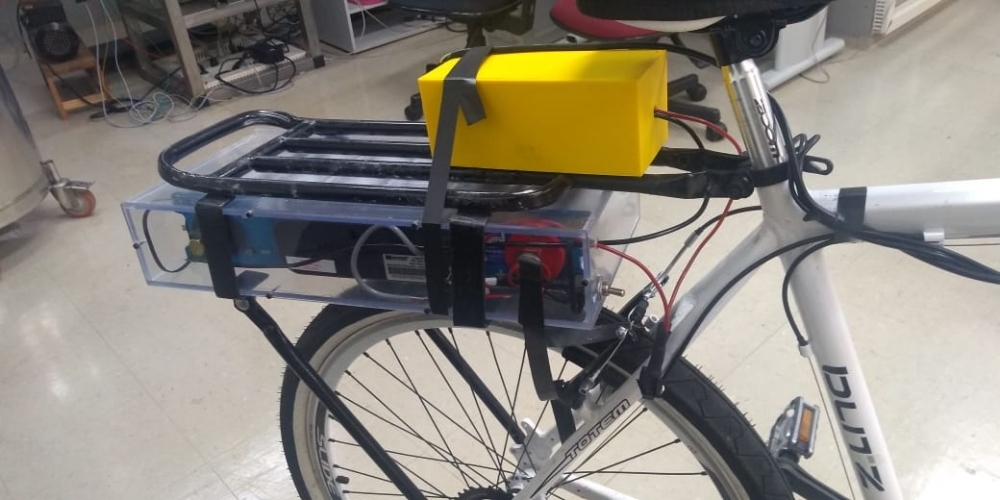


Study by FAPESP-Shell Engineering Research Center hosted at University of Campinas set out to develop supercapacitors that store more energy and batteries that charge faster (photo: electric bicycle that recharges in 3 minutes and has a range of 2 km – powered solely by a commercial supercapacitor pack / CINE)
Published on 03/16/2021
By José Tadeu Arantes | Agência FAPESP – Batteries and supercapacitors are complementary energy storage technologies. Batteries are more appropriate considering the total amount of energy stored, while supercapacitors are best when what matters is power, i.e. the amount of charging and discharging that can occur per unit of time.
In light of this complementarity, the Advanced Energy Storage (AES) Division of the Center for Innovation in New Energies (CINE), an Engineering Research Center (ERC) established by FAPESP and Shell, and hosted by the University of Campinas (UNICAMP), is working on both fronts to enhance the technologies so that supercapacitors store more energy and batteries charge faster and last longer.
Two articles published by the group illustrate this effort: “Radially ordered carbon nanotubes performance for Li-O2 batteries: pre-treatment influence on capacity and discharge products” and “Niobium pentoxide nanoparticles @ multi-walled carbon nanotubes and activated carbon composite material as electrodes for electrochemical capacitors”.
“In the first article, we show that surface functionalization is essential to enhance battery characteristics. We report a novel electrode for Li-O2 [lithium-oxygen] batteries based on multi-walled carbon nanotubes functionalized by pre-treatments leading to more effective active sites,” Gustavo Doubek, a researcher affiliated with the AES Division, told Agência FAPESP. The principal investigator for AES is Rubens Maciel Filho, a professor at UNICAMP and a member of the steering committee for the FAPESP Bioenergy Research Program (BIOEN).
In the first article, the researchers show that it is possible to use the large surface area of carbon nanotubes, with excellent electrochemical stability, for O2 adsorption and formation of LiO and LiO2, which are key to storage in Li-O2 batteries.
“The second article discusses ‘pseudocapacitors’, capacitors that use the advantages of Faradaic processes for batteries,” said Hudson Zanin, an AES researcher. Faradaic processes involve direct electron transfer by means of an oxidation reaction in one electrode and a reduction reaction in the other.
“The idea was to combine electrodes with a very large activated carbon surface area for electrostatic storage with niobium pentoxide, which can both oxidize and reduce,” Zanin said.
“In addition to quality, we’re producing in quantity, dealing with various issues that need to be addressed while developing battery and supercapacitor technologies. We have 40 active researchers and produce one article per month on average. We’re engaged in a concentrated effort to improve the interface between academia and industry so that all the knowledge created can be used by manufacturers here in Brazil.”
To improve the academia-industry interface, AES has begun operating the first pilot supercapacitor production plant in Latin America. Initially, it will produce supercapacitors, and at a later stage lithium-ion, lithium-sulfur, and sodium-ion batteries (more details on CINE’s YouTube channel).
“All cells are first produced on a small scale. They’re coin cells on small pastilles. We use these cells to analyze the changes that occur in the electrode and electrolyte as they charge and discharge. These initial tests enable us to understand the storage processes, make improvements and correct any flaws,” Zanin said.
“Once we’ve consolidated the best configurations, we enlarge the cells to 5 cm by 7 cm. These are pouch cells, rectangular devices similar in size to a smartphone. The goal is to develop systems that can be applied to electric vehicles by associating several of these cells.”
The article “Radially ordered carbon nanotubes performance for Li-O2 batteries: pre-treatment influence on capacity and discharge products” can be retrieved from: www.sciencedirect.com/science/article/abs/pii/S0920586119305279.
The article “Niobium pentoxide nanoparticles @ multi-walled carbon nanotubes and activated carbon composite material as electrodes for electrochemical capacitors” can be retrieved from: www.sciencedirect.com/science/article/abs/pii/S2405829719309201.
Source: https://agencia.fapesp.br/34678